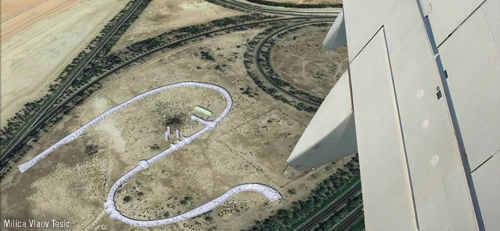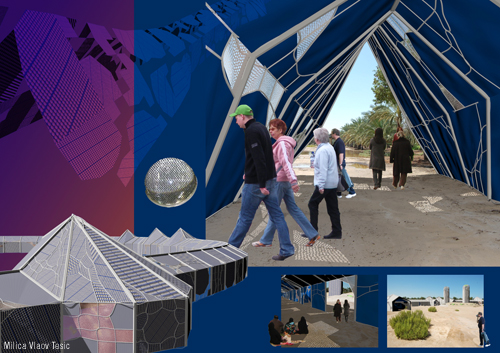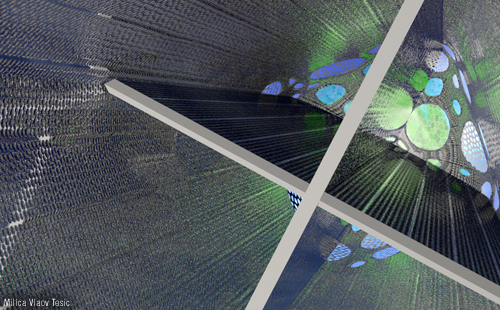Milica Vlaov Tesic
Designed for Site #3 in Abu Dhabi, on Airport Road near Masdar City.

Design Submission for the 2010 Land Art Generator Initiative Design Competition
Artist’s descriptive text:
Creating something beautiful and efficient is not an easy task. When we think about beauty that performs well, we firstly think about wonders of nature that amaze us every time we see them. Sometimes it seems people of ancient times understood better basic principles of nature. The Internet is big invention of our times and thanks to it, now we can reconnect with all the knowledge needed to create a sustainable society. By using broad knowledge of biology, vernacular architecture, Arabic culture and of course the latest technology, we came to this design. We called it Alshams or the Sun.

As part of design process we were drawing and writing in sand. Arabic letters were blending beautifully, looking almost as nature creations. Since the Site 3 is close to the airport, out design could be seen by plane passengers. The design is like one of the lines in sand, flowing and forming the word Alshams (الشمس) the Sun.
An elongated tent takes the form of the word. Why a tent? Because of its light structure, its common regional use, and its function as it can provide pleasant shelter for people and families on picnic. This is a new interpretation of the tent. The form is modified and dome shape photovoltaic solar cells by Kyosemi are attached on the outer face of the cloth, covering an area of 20,500 m2.
As part of the letter ش (sh) tree wind towers are positioned to cool an exhibition space. The towers are divided (diagonally) on four vertical channels. Towers are oriented at 45° to the prevailing wind in order for larger area to be available to catch the wind and to minimize turbulence at its entrance. Through two channels of the quadrant air is moving into the tower and trough two opposite ones the air moving out of the tower (due to the pressure created in the bottom part of the towers). Usually in the afternoon sea breeze will create a nice cooling effect and the whole exhibition area will enjoy a nice microclimate.

A plant native to Namib Desert, the Window Plant, is a dwarf succulent. A large part of the plant is underground and the top of this plant is semitransparent and contains chlorophyll. It protects itself from strong sun and still produces energy. Inspired by the window plant, the wind tower has an additional feature. On the top of the wind tower, windows are designed to allow some sunrays to go inside. Inside walls of wind tower are covered with mirrors and dome shaped solar cells. Glass of the windows is Sony dye-synthesized solar cells and some amount of energy is also produced by them.
Materials used are: concrete for support structure, rope as substructure, and locally made cloth as tent cover. By using new materials in concrete mix design concrete can became environmental friendly. Produced by natural mineralization process Calera materials (cement, aggregate) sequester CO2 from environment. Concrete made with these materials has zero carbon footprint while maintaining standard strength.

Related Posts
1 Comment
Add comment Cancel reply
This site uses Akismet to reduce spam. Learn how your comment data is processed.

[…] made with these materials has zero carbon footprint while maintaining standard strength. Source: Land Art Generator Initiative Reageer […]